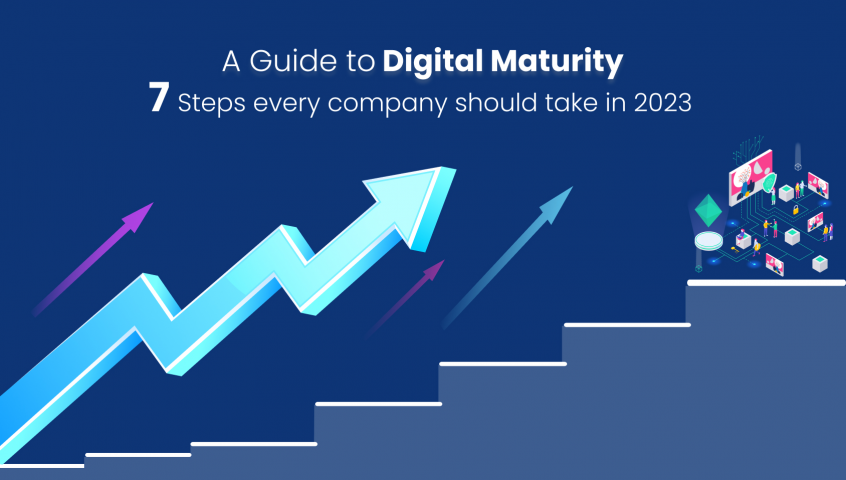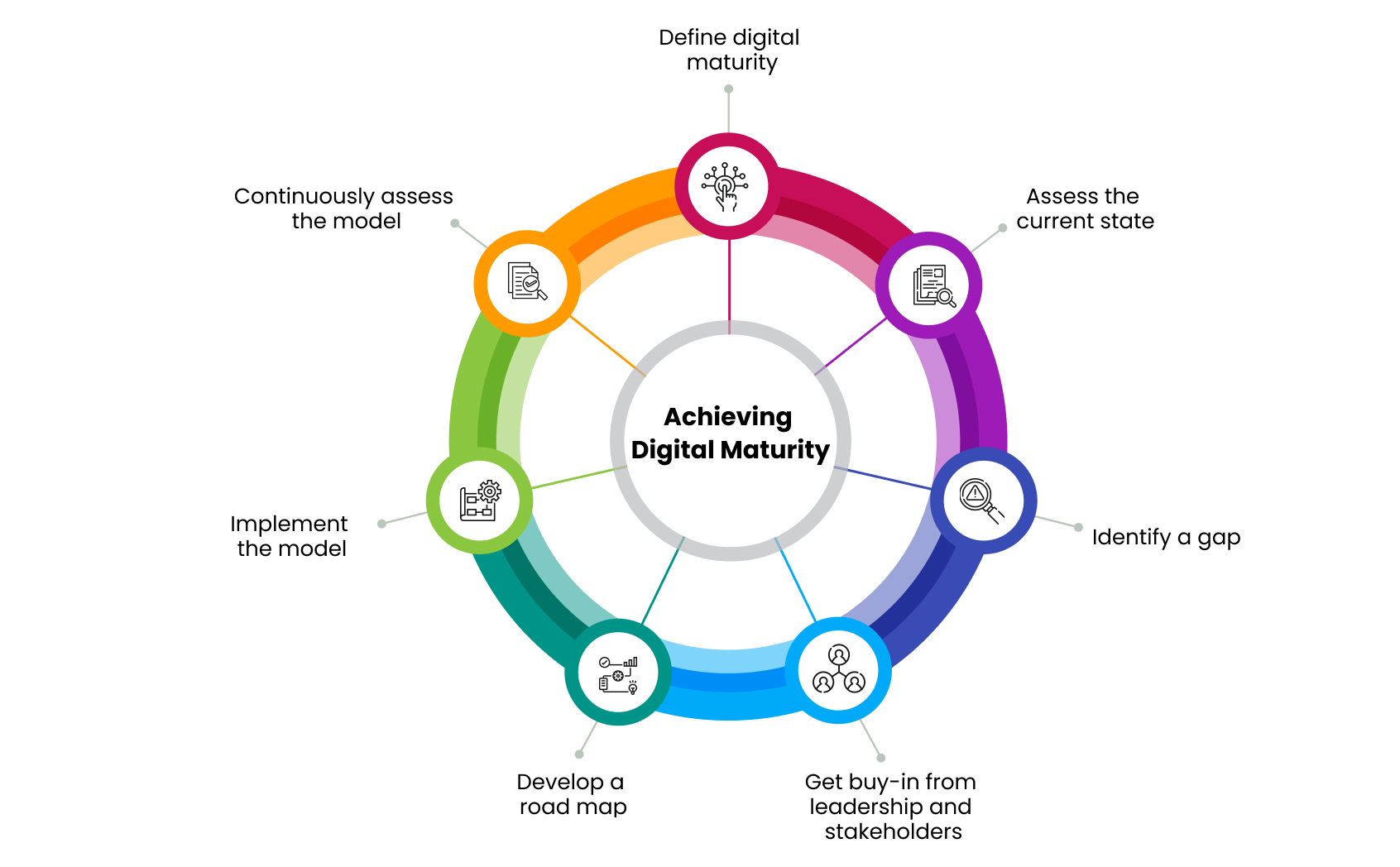
For companies to survive and thrive, digital transformation is imperative, and digital maturity is a complementary tool for assessing and advancing that transformation. While companies undergo digital transformation to improve their operations, digital maturity shows the level of sophistication the organization has achieved in embracing digital. A company's digital maturity is a measure of how well the company can adapt to market changes and respond to them. It's about staying at the top of your game and keeping pace with the dynamic market forces impacting your business. In the current age of digital transformation, however, it has gone far beyond a metric of a company's ability to anticipate and adjust to changes. It’s about how quickly they can identify opportunities and maximize their value in the digital ecosystem.
Advantages of Digital Maturity
Every firm is embarked on some kind of digital journey. Where they are with their journey, falls under the spectrum of the digital maturity model. The level of digital maturity shows how well a company is equipped to respond to consumer and market needs. In today's digitally obsessed world, the degree of digital maturity dictates a company's competitiveness and growth in the long term. Businesses with high levels of digital maturity are more likely to gain a competitive advantage and ace several performance metrics, like revenue growth, time to market, cost efficiency, product quality, and customer satisfaction. Here are some of the advantages that come with digital maturity.
- Enables continuous tracking and monitoring: A company, which is embarked on a digital transformation journey, won't reach its destination if it doesn't know its score on the digital maturity scale. The score will show whether initiatives taken to improve the health of the business and make it future-ready are reaping desired results or not. Since digital maturity encompasses all relevant dimensions, it lets companies gauge their performance at multiple levels, define targets for each department, monitor minute changes in the environment, and derive an overall score to assure they are on the right path.
- Improves decision-making process: When you have metrics in front of you, you are more likely to take informed decisions. The digital maturity exercise provides support to the intuitive process of thinking and backs it with logic and data. It strengthens analytical decision-making and data-driven leadership. The digital maturity assessment provides a comprehensive evaluation of a company's digital performance in terms of investments, the pace of change, and adaptability to new technologies and changing business environments. In short, it solidifies the company's digital strategy and governance.
- Increases revenue and customer satisfaction: The degree of digital maturity is directly proportional to the increase in revenue and customer satisfaction. The more digitally mature a company is the more technologically advanced, competitive, and innovative it is. Since they are constantly building ways to enhance the customer experience and adapt to the changes in the market, they are able to generate more revenue and set higher market benchmarks.
Achieving Digital Maturity
Achieving digital maturity is an iterative step-by-step process. It is not a quick fix, nor a 'one size fits all' exercise. An institution must be willing to commit time and resources to the process, and work incessantly towards its unique needs to see the desired results. A successful digital maturity journey looks like this:

- Define digital maturity: Once the company is on a digital transformation path, the question arises as to what digital maturity level the company is aiming for. Its definition defers from industry to industry, company to company, and process to process. Some may like to attain full digital nativity while others may just want to partially digitalize their business processes. Before boarding on a journey to digital maturity, enterprises should first define what it means for them, what objectives they wish to achieve with digital transformation initiatives, and what metrics are coded for various stages of the journey.
- Assess the current state: The journey to attain digital maturity starts with ascertaining the vision and assessing the current state of the digital capabilities. Check how the company is doing in the context of Digital IQ and Digital readiness. See if the company has been tracking technological advancements and implementing the right ones in a timely manner. Revisit your digital strategies and tactics to see if they are up-to-date and need any changes to gain a competitive advantage. Make sure you evaluate how the current digital initiatives are affecting the company in terms of business outcomes and customer experience. Finally, and most importantly, take a stock of employee readiness toward digital efforts. All the efforts toward attaining digital maturity will go futile if the employees are not in sync with the digital culture that the organization is trying to inculcate.
- Identify a gap: After assessing the current state, identify the gaps in your digital maturity framework. Compare the current level of maturity with the one that you had envisioned and measure the gap in terms of capabilities, tools, resources, and business outcomes. Prepare a report that identifies the gaps and defines the actions to bridge them.
- Get buy-in from leadership and stakeholders: Every digital transformation program’s success depends on the buy-in from the leadership team and the stakeholders. They are the ones who will approve or reject the program and provide the necessary resources to execute the plan. It is important to gain their support and ensure they are aligned with the proposed plan.
Digital Transformation Strategy: 8 Key Components can provide more insights into the components of a successful digital transformation strategy, which is crucial for defining your digital maturity goals.
Take them through an assessment of the current state and the gaps that are required to be bridged. Emphasize the importance of the proposed change and how it can help the organization remain relevant and competitive. Present a timeline for the program and explain how it can help various stakeholders and departments. Make a note of suggestions and feedback and include them in the digital maturity strategy. - Develop a roadmap: When you have an understanding of the goals, current state, and vision of the leadership, finally get on developing a digital maturity strategy. Ensure that it aligns with your business goals and fills the gaps in the current state. A strong digital maturity model should include a timeline (mentioning key milestones and deliverables), a plan for change management, technology investments, and talent upskilling. The strategy should talk about the roles and responsibilities of the stakeholders and ensure a smooth transition. It should also discuss the key risks and potential obstacles that can slow the speed of transformation.
- Implement the model: After finalizing the digital maturity model, bring the plan into action. Implement the technology and talent acquisition strategy. Adopt the digital mindset and technological tools that best suits your business needs. Create a communication plan for the employees and keep them up to date about the transformation. Identify the roles that will be affected by the changes and provide training to them. Allocate adequate resources to the program and keep a track of the milestones. Push the limits to slide the organization to the next level of maturity. Remember that digital transformation is a team effort and needs collaborative efforts from all levels of the organization.
Assess the model (continuously): Regularly assess the progress and see where the organization stands on the digital maturity spectrum. Compare the results with the initial assessment and make a note of the new challenges that need to be addressed.
Establish a culture of continuous improvement and use data to drive decisions and optimize processes. The regular checks, at every stage of the model, will help in identifying the areas of improvement, save time and resources and help in overcoming the hurdles in time.
Use data analytical tools to continuously monitor the progress and check if the efforts are on the right track. Track the milestones and adjust the plans as needed. Along with the internal audit, also do competitive analysis to understand the gap in the industry.
Conclusion
In its truest sense, digital maturity is a team effort. Individuals, at all levels, must drive digital transformation not only from the standpoint of technology but also from a pan-organizational perspective. On the path to digital maturity, companies often overlook the importance of people, culture, and processes. While there is a heavy emphasis on technology, the company must also focus on inculcating the right culture and people's behaviors. The organization's readiness to adopt new digital technologies and respond to the changing demands of its customers significantly depends upon the agility of its people and processes.
The more mature an organization digitally is, the more ready they are for the future.
Digital maturity has emerged as the new frontier for making a business future-proof. A Deloitte study says businesses with higher maturity are about three times more likely to report revenue growth. A digitally mature company is more likely to survive and thrive in an uncertain economic environment, as it equips them to be more resilient against both technological and market upheavals. Moreover, as the push for innovation continues to intensify, the need for moving up in the maturity scale is getting paramount.
Contact us
Take a look at this case study where Qentelli partnered with the client for Engineering Transformation and re-architected their entire legacy portal.
Contact us for an assessment of your company’s procedures and transform your business with Qentelli! Simply send an email to info@qentelli.com to get in touch with us!

